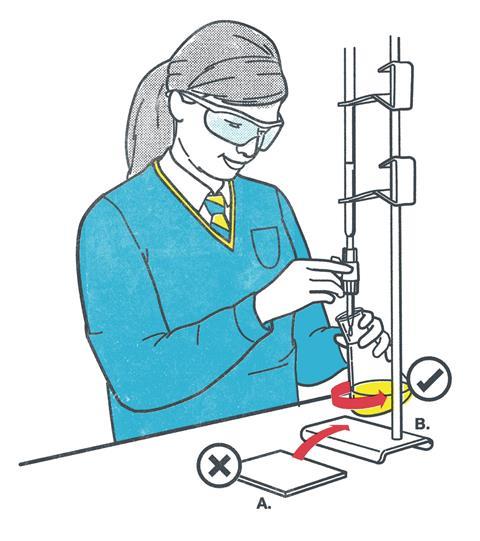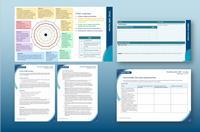Help your students acquire the practical skills they need for success

Practical work is well established in post-16 qualifications. Exam boards have placed it at the heart of courses. I teach AQA A-level chemistry which particularly emphasises ‘the development of knowledge and understanding of skills, scientific ideas, processes, techniques and procedures’. This approach motivated me to change the way I assess and monitor students’ practical skills so that it is now at the heart of my teaching.
In order to improve students’ skills it is essential they appreciate how they are assessed, recognise what competency looks like, understand how to improve, and are given multiple opportunities to flex these skills.
Modelling
When teaching new skills, I integrate modelling into my lessons. For example, when students complete their first titration, I first demonstrate the process, questioning students throughout to ensure they understand each step. I encourage students to assess me as I complete the task. I ensure I make all of the common mistakes, such as forgetting to use a white tile, leaving the funnel in the top of the burette, or missing the end-point. I show them what a good example looks like, for example swirling, reading the burette at eye-level and recording data to two decimal places. This helps students to recognise how small aspects of the practical can impact my overall competency.
Modelling also works during the analysis stage of practical work. In the early stages of the course, I may provide students with a results table. Students will learn to record data systematically in a suitable format. I encourage my students to recall important aspects, such as including units in the headings. Follow-up calculations can also be modelled to help students.
-

Download this
Practical skills tracker, for age range 16–18
Use the tracker and linked tools to provide meaningful feedback, encourage reflection and set targets for development of key practical skills.
Download the teacher notes as MS Word or pdf, skills tracker as PowerPoint or pdf and student peer assessment form as MS Word or pdf.
Download this
Practical skills tracker, for 16–18 years
Use the tracker and linked tools to provide meaningful feedback, encourage reflection and set targets for development of key practical skills
Download from the Education in Chemistry website: rsc.li/3YcDhlf
Giving feedback
Once students have completed the activity, it is essential to give them clear, meaningful feedback on their work. Students can identify aspects of their own work which are good examples of the skill, for example a time when their working has been clear and sequential rather than unstructured, or when they have referenced a source in full using the correct formatting.
Recommended reading and resources
- Slow practicals are a great way to model practical skills for students at all stages.
- Our interactive screen experiments give learners the opportunity to practise developing their skills outside the lab.
- Learn how to make the most of videos to complement your teaching of practical skills and use our core practical videos for learners aged 14–16 and for 16–18.
- See practical skills in careers as Claire, a bioanalytical scientist, talks about her job in pharmaceuticals.
Recommended reading and resources
- Slow practicals are a great way to model practical skills for students at all stages: rsc.li/3ICL4nT
- Our interactive screen experiments give learners the opportunity to practise developing their skills outside the lab: rsc.li/3ElFzHK
- Learn how to make the most of videos to complement your teaching of practical skills and use our core practical videos for learners: rsc.li/3kcItrC
- See practical skills in careers as Claire, a bioanalytical scientist, talks about her job in pharmaceuticals: rsc.li/3IEw5dt
Reapplying
After feedback, students get an opportunity to pick up on their mistakes and test the skill again, for example by carrying out another titration activity. I have found that my students perform much better, as they have a clear understanding of their areas for improvement and how to succeed. Allowing them to act on your feedback within a short timeframe is the most helpful approach for their progression. When revisiting similar practical activities again later in the course, I was especially pleased to see that the majority of my students had retained their understanding successfully, and could recall the important skills and how to apply them.
This model, feedback, reapply loop has proved very successful in my teaching, for example in the following practical activities:
- titrations, revisited during redox, transition metals, acids and bases (where a pH probe is introduced)
- calorimetry experiments, revisited in thermodynamics (enthalpy of solution)
- identifying ions, revisited during transition metals
Previously, I found any assessment of practical work created a tense, anxious atmosphere in my lab. This approach has helped to give the whole process purpose and meaning. Students don’t feel this is a negative experience or that they are being criticised. I am now able to support my students in their learning by modelling good technique, providing meaningful feedback to support their progression and enabling them to try again until they achieve success.

This article is part of our Teaching science skills series, bringing together strategies and classroom activities to help your learners develop essential scientific skills, from literacy to risk assessment and more.









No comments yet